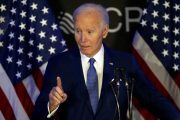As a former chairman of the Joint Chiefs of Staff, retired Admiral Thomas H. Moorer defies the stereotype of an “anti-government conspiracy kook.” The honor and distinction with which he served our country confer upon him the moral standing to criticize abuses of power by our government. Thus it is of great significance that Admiral Moorer has lent his name and prestige to the growing dissent from the federal government’s official line regarding the July 17, 1996 TWA 800 disaster.
“It absolutely deserves more investigation,” Moorer declared at a January 8th press conference in Washington, DC sponsored by Accuracy in Media (AIM). AIM had convened the press conference in order to present expert critiques of the federal government’s conclusion, made public in early December, that the Paris-bound Boeing 747 had fallen victim to a catastrophic mechanical failure, rather than a criminal act. The official story is that residual fumes in the plane’s center wing tank were somehow ignited by a random spark; 230 people were killed in the ensuing explosion over the Atlantic, which occurred at 8:47 p.m. Eastern Daylight Time, eleven and one-half minutes after the plane’s takeoff from JFK Airport.
The federal investigation, which was spearheaded by the FBI, consumed some 18 months and $100 million. That investment in effort and money produced a tardy and dubious vindication of the “mechanical failure” thesis, buttressed by a slick, CIA-produced, 14-minute animated film entitled TWA 800: What Did the Witnesses See?
Early in the investigation, James Kallstrom, the FBI’s chief investigator in the case, declared, “We know there was a catastrophic explosion. It was caused by some kind of bomb, obviously.” For reasons that have never been adequately explained, that “obvious” explanation was hastily discarded, and evidence tending to substantiate the bombing theory was studiously ignored by federal investigators. Ironically, as he handed off the investigation to the National Transportation Safety Board (NTSB) last November, Kallstrom declared — with more than a hint of defensiveness — that his agency is “the Federal Bureau of Investigation, not the Federal Bureau of the Obvious.”
Meteor Strike?
“All evidence would point to a missile,” Admiral Moorer told the January 8th press conference. “All those witnesses who saw a streak that hit the airplane — you have to assume it’s a missile. In an investigation like this, you can’t overlook anything.” Federal investigators have been willing to consider some rather improbable scenarios — as long as they don’t involve a missile. For example: During last December’s NTSB hearings about the Flight 800 tragedy, investigators and “experts” speculated that the explosion might have been caused by a meteor strike — something that, unlike missile or bomb-related terrorism, is entirely without precedent in the history of commercial aviation. As was the case with the CIA’s 14-minute video, the “meteor strike” theory was floated as a way of explaining eyewitness accounts of a bright object intersecting with the plane.
Yet there remains the problem of the scores of eyewitnesses — some with military and technical backgrounds — who remain convinced that what they saw distinctly resembled a missile. Among those witnesses is Long Island furniture maker Richard Goss, who also addressed the AIM press conference. Just prior to the explosion of Flight 800, Goss saw what appeared to be a missile contrail. When he first shared his account with FBI investigators, they were “very amazed” and quite receptive, Goss recalled. However, he continued, for reasons yet unexplained, the FBI summarily dismissed his eyewitness testimony and “I never heard from them again.”
Also on hand at AIM’s press conference was attorney Frederick Meyer, a Vietnam veteran who flies helicopters for the Air National Guard. On the evening of July 17, 1996, Meyer was piloting a helicopter on maneuvers near the site of the disaster, which literally took place in front of him. “I saw what I swear to God was military ordnance explode,” Meyer informed the press conference. “The aircraft I saw came out of the air like a stone.” Contradicting the official account, in which a portion of the doomed aircraft briefly continued its ascent after the cockpit had been sundered from it, Meyer insisted: “Nobody saw the aircraft climb a foot after it was hit. The CIA cartoon bears no similarity to what I saw.”
Meyer also voluntarily approached the FBI with his account. Investigators conducted two perfunctory interviews with him, and then let the matter drop. Meyer also pointed out that he has spoken with several other eyewitnesses who volunteered information to the FBI, only to be ignored completely.
The Final Seconds
In the Flight 800 investigation, suppression or dismissal of eyewitness testimony appears to be the rule, rather than the exception. Retired Navy Commander William Donaldson, a former Naval aviator and JAG (Judge Advocate General) investigator who now serves as AIM’s aviation consultant, maintains that the FBI “is holding the lid on” 96 witnesses who recall seeing a bright object climb into the sky before the explosion. “Most of those people are scared to death right now,” Donaldson explained at the press conference.
“This is either a train wreck in the sky, or an explosive device mid-air, outside the plane,” Donaldson says. He insists that critical evidence of a missile strike can be found in data collected from the doomed aircraft’s flight recorder, specifically, the readings taken from the flight’s final five seconds. According to the data, the plane plunged 3,600 feet in the final seconds, and its velocity simultaneously plunged from 295 knots to 100 knots — readings that defy the physics of aviation. The NTSB data were brought to Donaldson’s attention by retired TWA Captain Howard Mann, who — unlike most of the press — had carefully scrutinized the readings for the plane’s last five seconds, which on the chart provided by the NTSB fell beneath a line identified by a hand-written notation as indicating the “End of Flt. 800 Data.”
As summarized by the Gannett News Service, “The final readings show chaos in the sky — with airspeed dropping instantly by almost 200 knots, the pitch angle jumping five degrees, altitude dropping 3,600 feet in about three seconds, the roll angle going from zero to 144 degrees (the plane almost inverted), and magnetic heading changing from 82 degrees to 163 degrees. The small vane that measures wind angle striking the nose — situated on the left forward fuselage — goes from 3 degrees to 106 degrees back to 30 degrees.”
Commander Donaldson has suggested that such data could be the result of a missile strike resulting in an extreme high-pressure wave coming from the lower left side of the jet. As corroboration for this theory he cites the fact that divers found debris from the forward fuselage more than half a mile to the right of the plane’s extended flight path, strongly suggesting that it had been propelled by a powerful explosion on the plane’s left side. In addition, fuselage doors from near the front of the craft had been bent and dented inward, and more damage had been done to the plane’s left wing than to its right wing. All of this indicates that “there was an explosion — a big explosion — outside the cockpit,” Commander Donaldson concludes.
“The fact this vital data [from the flight recorder] is lined out and not even discussed suggests a cover-up,” argues Donaldson. “The only reason you put flight data recorders into an airplane at millions of dollars cost is to capture this last data line.” To parry the protests of dissenting pilots, the NTSB claimed that the data had simply bled through from a previous flight — an explanation that doesn’t pass the “laugh test” for Captain Mann and Commander Donaldson.
Donaldson’s study of the Flight 800 data has led him to believe that the FBI/NTSB “investigation” is actually an exercise in cover-up and federal image maintenance.
Other Possibilities
One immensely qualified analyst who agrees in part with Commander Donaldson is Brigadier General Benton K. Partin (USAF, Ret.), one of the world’s leading experts on military explosives and missiles. General Partin, who has a master’s degree in aeronautical engineering, also found his attention drawn to the data from Flight 800’s final seconds — but draws different conclusions when considering other vital information.
“The pilots I’ve talked to don’t regard that last data line as reliable, and I can’t regard it as reliable either,” Partin told The New American. “However, the eyewitness account provided by Major Meyer — who was probably the most qualified observer, and he was headed straight toward the event — coupled with evidence gathered from the recovered wreckage, suggests a different scenario from the one offered by Donaldson, involving one, if not two, missiles using continuous-rod warheads.”
A continuous-rod (CR) warhead is detonated with a proximity fuse, which means that it would not actually collide with the aircraft. The detonation causes an expanding, accordion-style steel rod to unfold which slices the target in two. “If you examine the assembled wreckage of Flight 800, you can’t help but notice how cleanly the 80-foot forward section was severed from the aircraft in front of the wing,” General Partin observes. “It looks like a melon that’s been cut with a saber. Well, that’s exactly how a CR warhead is supposed to work.” Partin further observes that the recovered fuselage wreckage, unlike the forward section, “displays a lot of soot and fire damage. The forward fuselage, however, is remarkably free of that type of damage. This suggests that it was not a full explosion that did that particular damage, meaning once again that a CR warhead may have been responsible.”
General Partin notes that “Major Meyer has testified to seeing two separate flashes, the latter of which grew into a fireball. This also fits the CR profile, assuming that two separate missiles were fired, and that’s a sound assumption, given that shoot-downs almost always involve two missiles — as was the case with the KAL 007 and Iranian Airbus shoot-downs. If a CR warhead was used against Flight 800, the first would have cut off the forward fuselage, and the second would have cut into the fuselage, causing a full explosion and fire.”
The CR warhead theory would also provide an explanation for the FBI’s decision to give missile-related scenarios a wide berth. “This technology isn’t readily available to common terrorists, and not many people have it,” he pointed out. “We developed it in the 1950s. The Russians are up to their ears in CR technology as well.” A CR-related scenario thus implies either a tragic “friendly fire” incident, or an act of foreign terrorism. Referring to speculation that Flight 800 might have been felled by a submarine-launched missile, Partin observed, “None of our submarines carry CR-equipped missiles. However, many Russian-manufactured subs carry them.”
However remote the possibilities suggested by General Partin and Commander Donaldson may seem, they should hardly be dismissed outright by those willing to entertain the NTSB’s “meteor strike” scenario.




